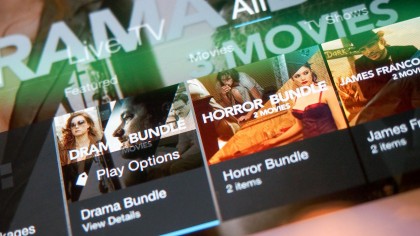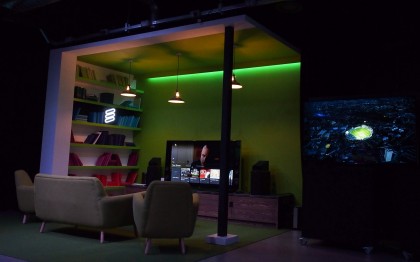Ericsson has an ambitious plan to save traditional cable providers
Where linear TV and over-the-top come together

Imagine a world where every linear television channel that matters agrees to sell its content directly via an app. HBO already does, and a slew of others are effectively doing the same through the Sling TV service. Now, imagine all of those programs being searchable, mineable, and sortable using a well-regarded interface on Apple TV and Roku's assortment of streaming products.
In a world where our internet connections are all solid enough to handle IP-delivered content, that's a recipe for disaster if you're a traditional telco or cable provider.
Now, imagine a world where the aforesaid cable provider gets its design in order and beats those apps to the punch. That's the dream that Ericsson is hoping to enable, and by every measure, the race against time is most definitely on.
A timely addition

You may not link a name like Ericsson with the saving of cable, but the company best known for connecting billions of mobile lines the world over has invested heavily in TV and media over the past decade. For an organization founded some 140 years ago, its decision to dive into media seems awfully nimble (and equally wise).
I recently spent a week in the United Kingdom, peeking into the company's Southampton Experience Center as well as its Broadcast Center in central London. What I found largely didn't exist a decade ago, but could very well be the concoction that prevents what many view as the inevitable upending of television.
Simon Frost, Ericsson's Head of TV Marketing, told me that Ericsson had no reason to show itself at NAB ten years ago, but as I wondered around racks of encoders, decoders, and all manners of other-coders blinking incessantly, a frenetic team was readying a high-end reference monitor for shipping to Las Vegas. "It's our biggest event of the year now," said Frost.
It's all about the software (and design, too)

If you're curious what Ericsson's role in media and TV is, you aren't alone. For a company that claims upwards of 115,000 employees, it manages to fly largely under the consumer radar. Take, for example, the UI on AT&T's 19 million U-verse TV boxes -- that's Ericsson. But it's also just the "tip of the iceberg," as described by Michael Armstrong, the firm's Head of Sales Support for Media.
Sign up for breaking news, reviews, opinion, top tech deals, and more.
Indeed, it's what I saw in its MediaFirst TV Experience Center: an interface -- and a backend labyrinth of intelligence -- that every telco and cable provider in the Unites States needs to remain relevant.

The demo utilized an Android-based set-top box, but as it turns out, pretty much any modern Android puck would do. That's a radical departure in its own right, and it's at the heart of the ongoing FCC "Unlock The Box" proposal which would overhaul the borderline criminal process of forcing American pay-TV customers to rent these giant boxes with archaic electronic program guides just to get service.
The MediaFirst TV user interface is far slicker than anything you've seen on set-tops thus far -- TiVo boxes included. It lightly resembles Android TV, allowing a program to continue in the background while translucent overlays showcase current programs, favorites, recommendations, and an app catalog. It's not all that novel at a glance, but the proverbial ace in the hole is the fact that linear television channels are just as tightly integrated as Hulu episodes, VOD content from the pay-TV provider, and the latest Narcos series on Netflix.
Integrate or die

This has all been attempted before, but crucially, at a very different stage in the process. Google TV was supposed to bring this dream to reality -- a reality where over-the-top content from myriad internet sources were made one with the linear TV programs that cable users just can't quite cut. (You know, the likes of TNT, ESPN, CNN, etc.)
The issue there was twofold. One, Google TV sat after one's set-top box in the chain of products connected to your television, so you still needed that dreaded set-top from your cable or satellite provider. Two, it required the aforesaid providers to trust Google on a level that many just weren't comfortable with.

MediaFirst TV is the set-top box, which puts the control back in the hands of the provider. That makes carriers like Telus, which will soon be the first to deploy the system to its Optik TV customer base in Canada later this month, a lot less queasy.
A search box, which supports both keyboard inputs as well as the spoken word, seeks to accomplish what many would call pure magic: presenting users with results that span the gamut, from Netflix to Hulu to HBO Now to VOD to linear TV. Ericsson also happens to be a master of metadata -- it constructs, collects, and organizes a mind-boggling amount of it, which is vital for search to function well.

When I asked if it was truly possible for searches to yield results from every imaginable content library rather than a curated handful, I generally heard this: "Yes, if the pay-TV carrier and all of the services you subscribe to allow their repositories to be mined." That's asking a lot from a cadre of companies that would all rather you remain in their own ecosystem than transfer in and out, but at least it's possible.
The other important element here is universality. In the Telus example, customers will be able to download a Telus-branded app on whatever mobile device they please, and the interface they see on their TV will also be in the palm of their hand. If you start watching something in your living room and pick it up a few hours later on your phone, it'll resume from the right place with no effort on your part. (That also works going from mobile back to your home entertainment center.)
Perhaps most impressive was the proximity demo, whereby a logged-in MediaFirst user with an iPhone walks into the living room. Then, without lifting a finger, the Bluetooth LE-enabled set-top recognizes that person's presence, recognizes what show they were just watching, immediately logs them in and resumes playback. To sweeten things further, the platform is capable of having multiple users logged in at once to capture the kinds of programs a couple or group watch together.
Can traditional TV be personal?

Which brings me to this: personalization. When speaking with Steve Plunkett, CTO of Ericsson's Broadcast and Media Services, the question keeping him up at night is whether or not massive amounts of anonymized data holds the key to truly personalizing television. Mastering the art of recommendations is no easy task. Netflix, Amazon, Hulu, Google, and pretty much any other company moving petabytes of data on a daily basis have been trying to nail it for years.
Algorithms, when they work, are akin to wizardry. They suggest what you need, when you need it, staying one step ahead of your own brain. They're different for everyone, though, which is why they're hard to master. To boot, users move from device to device, and for obvious reasons related to privacy, it's often difficult to pinpoint who exactly is watching what.

With MediaFirst, linear TV viewing and app-based viewing are combined like never before. That, in theory, would allow a fan of TNT's Major Crimes to get a recommendation for Netflix's Bosch. That crossing of divides has thus far been impossible, and it's in that small example that we see the potential for TV to be saved.
Cord cutters typically cite cost as the reason for ditching their pay-TV subscription and leaning solely on Netflix, Hulu, and perhaps a lightweight Sling TV or PlayStation Vue package. But really, it doesn't take too many of those subscriptions before you're paying nearly as much as you would for a massive bundle of 300+ channels that never buffer or suffer pixelation due to internet hiccups.
To boot, the technically-savvy have no problem hopping between apps to watch the content they want to watch. It's little fuss to mentally wade between recommendation silos in Netflix, Amazon, and Hulu. But what about the laypeople? The folks who, after an exhausting ten-hour day, plop down on their couch and dream of mashing one button to conjure up the perfect recommendation that looks across every source imaginable.
The war for your screens

We've reached an inflection point in the life of television. Apple believes the future of TV is apps, but a number of billion-dollar enterprises like Comcast and Time Warner Cable would argue otherwise. The truth, as it often does, probably lies somewhere in betwixt.
Linear TV is still special, but its mistake was failing to innovate on the discovery and recommendation front. The Holy Grail of TV is a service that can look across every content house, into every line of metadata, and offer up recommendations that aren't biased towards one owner or another in just milliseconds.
I tasted the sweet elixir being poured from that chalice, and it was good. Now, to see if pay-TV providers recognize how severely they need a dose of their own.
